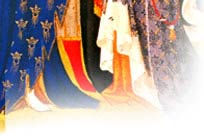 |
|||
 

|
Medieval Clothing From the 11th through the 13th centuries, medieval clothing varied according to the social standing of the people. The clothing worn by nobility and upper classes was clearly different than that of the lower class. The clothing of peasants during the Middle Ages was very simple, while the clothing of nobility was fitted with a distinct emphasis on the sleeves of the garments. Knights adorned themselves with sleeveless "surcoats" covered with a coat of arms. Barbarian nomads wore clothing made of fur, wool, and leather. They wore long trousers, some of which had attached feet. Fine leather shoes were also worn. Imports such as turbans and silks from the East were common for the more fortunate of society. As with today, clothing styles of medieval men changed periodically. At the end of the 13th century, the once loose and flowing tunics became tighter fitting. Besides tunics, the men also wore undershirts and briefs covered by a sleeveless jacket and an additional tunic. Stockings completed the ensemble. Men's medieval clothing also consisted of cloaks with a round opening that was slipped over the man's head. Such cloaks were worn over other clothing as a type of "jacket". Early medieval women's clothing consisted of "kirtles", which were tunics worn to their ankles. These tunics were often worn over a shirt. When the women were in public, they often topped the tunics with an even shorter "kirtle." Of course the more affluent women wore more luxurious clothing than those of the less affluent lifestyle. Women, especially those who were married, wore tight-fitting caps and nets over their hair, which was wound in a "bun" on their heads. Other women wore veils over their hair, which was left either hanging loosely, or braided tightly. |
 |
|
 |
|||
 |
|||